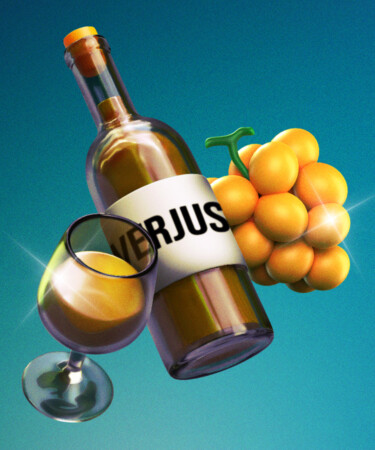As the category of non-alcoholic beverages continues to expand, it can be easy to get lost in the sea of booze-free wine, beer, and spirits. But amongst the ruckus, there’s a simple non-alcoholic option with a long history in the category that deserves to be on your radar: verjus. You might be familiar with the term from cocktail recipes or product labels, but what exactly is verjus, and how is it made? We called upon expert Roman Roth, winemaker at Long Island’s Wölffer Estate, a winery that makes a full lineup of verjus in addition to their portfolio of wines.
Verjus is a crisp and fruity liquid that lies somewhere between wine and Welch’s grape juice. It’s made by pressing unripe grapes to extract a bright, acidic juice. Since the product doesn’t undergo fermentation, it’s naturally non-alcoholic. However, it’s a bit different than your typical grape juice as it’s made from wine grapes and picked extremely early in the growing season, so it’s fresh and light on the palate instead of sweet and cloying. Roth says Wölffer’s version is produced with grapes from its estate vineyards (Chardonnay for the white and Merlot for the red).
“Normal grape juice is very sweet, with little acidity, and is usually pasteurized to be sterile,” Roth says. “The Wölffer verjus is vibrant and fresh with bright acidity and balanced sweetness, and is cold-sterile-filtered in order to protect the delicate fruit.”
In addition to being bottled solo, other producers are using this product as the base for their non-alcoholic wines, adding other extracts and botanicals to replicate the flavor profiles of your typical bottles. Kally’s Golden Sparkler, which was featured on VinePair’s list of best non-alcoholic wines for 2024, is made with Chardonnay verjus, organic apple juice, green tea, black tea, jasmine, and spearmint to add complexity.
Roth mentions that chefs and adventurous at-home cooks enjoy using Wölffer’s expression when cooking as a substitute for vinegar, lemon juice, or wine in sauces, mustards, or salad dressings. He also suggests trying it out as a component in a refreshing spritzer or no- or low-alcohol cocktail.
“Although dating back centuries, verjus is enjoying a resurgence among creative chefs in search of natural and healthy ingredients to enhance a range of dishes,” he says. So the next time you’re looking to add some zest to your salad dressing or a tart kick to your NA spritz, try the OG non-alcoholic wine product.
*Image retrieved from FOOD-micro – stock.adobe.com
